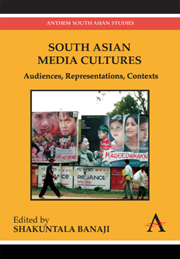Book contents
- Frontmatter
- Contents
- List of Illustrations
- 1 Introduction
- Part One Elaborating Audiences: Meaning, Use and Social Context
- Part Two Telling Texts: Media Discourse, Identity and Politics
- 6 Private Satellite Media and the Geo-Politics of Moderation in Pakistan
- 7 Forgetting to Remember: The Privatisation of the Public, the Economisation of Hindutva, and the Medialisation of Genocide
- 8 Myth – The National Form: Mission Istanbul and Muslim Representation in Hindi Popular Cinema
- 9 A Peace of Soap: Representations of Peace and Conflict in Popular Teledramas in Sri Lanka
- 10 Destigmatising Star Texts – Honour and Shame among Muslim Women in Pakistani Cinema
- Part Three Alternative Producers: The Articulation of (New) Media, Politics and Civic Participation
- List of Contributors
10 - Destigmatising Star Texts – Honour and Shame among Muslim Women in Pakistani Cinema
from Part Two - Telling Texts: Media Discourse, Identity and Politics
Published online by Cambridge University Press: 05 March 2012
- Frontmatter
- Contents
- List of Illustrations
- 1 Introduction
- Part One Elaborating Audiences: Meaning, Use and Social Context
- Part Two Telling Texts: Media Discourse, Identity and Politics
- 6 Private Satellite Media and the Geo-Politics of Moderation in Pakistan
- 7 Forgetting to Remember: The Privatisation of the Public, the Economisation of Hindutva, and the Medialisation of Genocide
- 8 Myth – The National Form: Mission Istanbul and Muslim Representation in Hindi Popular Cinema
- 9 A Peace of Soap: Representations of Peace and Conflict in Popular Teledramas in Sri Lanka
- 10 Destigmatising Star Texts – Honour and Shame among Muslim Women in Pakistani Cinema
- Part Three Alternative Producers: The Articulation of (New) Media, Politics and Civic Participation
- List of Contributors
Summary
Introduction
Lollywood is the nickname given to the Pakistani film industry, predominantly based in Lahore, one of Pakistan's most historic cultural centres. A career in Lollywood is glamorous yet it lacks prestige. This chapter examines Lollywood actresses as star texts, concentrating broadly on the intersection of gender, class and ethnicity, and specifically on Reema, one of Pakistan's most famous female celebrities. Like a number of film actresses, Reema allegedly hails from the Kanjar ethnic group, a community of prostitutes and dancing girls – a detail which overshadows her public persona.
Beginning with a brief history of cinema in Pakistan, the chapter will consider notions of morality in Islam, and how these affect the Kanjar community. It will then examine the ways in which the Kanjar taboo influences how Lollywood actresses are publicly perceived, before exploring some of their strategies to ‘sanitise’ their own star texts. The chapter explores the extent to which financial success helps Lollywood actresses to renegotiate notions of honour, shame and morality. Given its avowed interest in public perception and the scarcity of official material, the research in this chapter concentrates on newspaper articles, internet chat room discussions, and talk show interviews from Pakistan. Pakistani cinema has received barely any attention, particularly in English publications. Only one book exists, which covers 50 years of cinema since partition (Gazdar 1997) and a handful of Urdu books written by journalists and scriptwriters may be found, featuring personal reflections rather than academic analysis.
- Type
- Chapter
- Information
- South Asian Media CulturesAudiences, Representations, Contexts, pp. 181 - 198Publisher: Anthem PressPrint publication year: 2010



